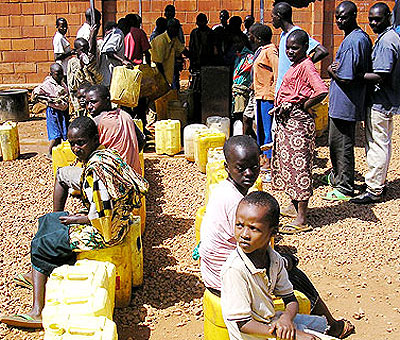Last month or so, several areas in the City of Kigali, including Gikondo, Kicukiro and Nyamirambo, suffered acute water shortage,. The authorities blamed the problem on power cuts. The situation has, however, since improved. The Business Times’ Ivan R. Mugisha caught up with James Sano, the Energy, Water and Sanitation Authority (EWSA) deputy director general in charge of water and sanitation, who explains the strategies EWSA has devised to address the challenge.


Last month or so, several areas in the City of Kigali, including Gikondo, Kicukiro and Nyamirambo, suffered acute water shortage,. The authorities blamed the problem on power cuts. The situation has, however, since improved. The Business Times’ Ivan R. Mugisha caught up with James Sano, the Energy, Water and Sanitation Authority (EWSA) deputy director general in charge of water and sanitation, who explains the strategies EWSA has devised to address the challenge.Several areas in Kigali continuously face water shortages, what is the problem?There is a challenge of population explosion in Kigali. Because the city is expanding in population size and economically, this has created a lot of pressure on the water supply network.Information from the Rwanda National Bureau of Statistics shows that the city’s population has tripled in 10 years to 1.2 million people. To satisfy this population, 120,000 cubic metres of water must be supplied every day, yet our present daily capacity is 70,000 cubic metres.This supply gap has forced us to ration water supply. Besides that, the occasional power cuts also affect as we can’t pump water.However, when you compare with previous times, the situation has greatly improved since 2000. We don’t have acute water shortages. Compared with the major cities in the region, water supply in Kigali is much better.There are challenges definitely, but we make sure that no place in the city faces acute water shortage. Rarely does any place go without water for two days; that would be a crisis for us.What is the status of the water network in Kigali?Kigali is supplied by three main treatment plants; Nzove plant on Nyabarongo River produces 27,000 cubic metres, the Kimisigara plant in the west, 23,000 cubic metres and Karenge in Rwamagana District produces 14,000 cubic metres. Other small plants produce a combined total of 6,000 cubic metres per day. Our water supply network, especially in city outskirts like Nyamirambo and Kimisagara is so old, dating back to the colonial days.On the other hand, areas like Rebero stand on very high altitudes, so pumping water there is difficult and expensive.Water investors and donors most times are not interested in funding urban projects. For example, the World Bank targets rural areas mainly, yet the government lacks sufficient funds to facilitate water network expansion projects in urban areas.What measures are in place to increase water supply?Consumption per capita currently stands at about 100 cubic metres per day, and keeps increasing due to the fast economic development the country is experiencing.Every year, we connect an average of 15,000 new households to the water grid and the network is expanded by 200km annually to supply as many people as possible.We are planning to acquire a three mega watt standby generator so that we continue supplying the city even when power is off.We also plan to invest in large capacity water pumps and pipes to improve services to high altitude places.Also, under the Bulk Water Project, two new water treatment plants will be established in Nyanza and Juru hills in Kagarama and Bugesera, respectively, with a capacity to supply the city 40,000 cubic metres. The plants will be constructed by private investors who will manage them on a 25 year concession, although water distribution will remain the role of EWSA.This will be complimented by the Mutobo water supply project, which is underway to provide 100,000 cubic metres per day once it is completed. This will leave Kigali with a water surplus of about 25,000 cubic metres.Will the tariffs change?Water tariffs have not changed since 2006, which could explain why money collected is never enough to cover all operations and maintenance costs. There have been complaints about EWSA’s water billing system. People say they are charged more money compared to the water used. Why is this so?I acknowledge that this happens sometimes, but it is rare. The common cause is faulty water metres, but this is usually rectified within two days once the client reports it. However, some people delay clearing their bills, so the bills attract fines.When will the country have universal access to clean piped water?Most of the country is not affected by water shortage. The areas that have challenges are earmarked, including Gicumbi, Muhanga, Nyamata, Nyanza, Ruhango, Rwamagana, Kayonza and Ngoma districts.We are planning to introduce a mobile water treatment plant in each of the above districts, with a capacity of supplying 80,000 cubic metres per day.Also, there are plans to enhance the capacity of water wells that supply several districts in the countryside within the next three months.


